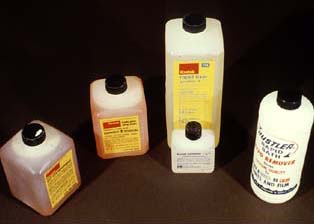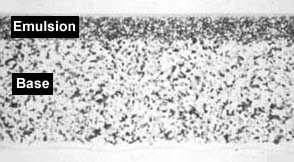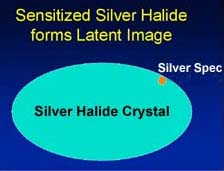Processing Angiograms
|
Janice Clifton, CRA COT |
Paul R. Montague, CRA FOPS |
Photographic Illustrations by |

Film is composed of an acetate base coated with a light sensitive emulsion. The emulsion side of the film is the side that faces the lens of the camera when taking a picture. The emulsion primarily consists of silver halide crystals suspended in a gelatin. These when struck by light, a few molecules of the silver halide convert to solid silver. These sub-microscopic particles appear more frequently in areas of the film that have been struck by more light, and less frequently in areas struck by less light. Once the negative is exposed to light in a camera, the halides and their converted solid silver specs hold the invisible image. It is a latent image.

Cross-section of B&W Film
Negatives are not very useful in this form. The film still contains silver halide crystals which have not been exposed to light, and doing so would destroy the latent image. Further, the latent image can’t be seen. So something must be done to make the image visible and safe from light.
Developer is an agent which reduces silver halide to solid silver. It’s key property is that the reaction is catalyzed by the presence of solid silver. This means that when the film is placed in photographic developer the silver halide crystals begin to convert to solid silver, but the areas where there are specs of solid silver are converted first. If the film is never developed, the image can’t be seen. If the film is placed in the developer for a long period of time, all of the silver halide will be converted to solid silver and the image will be entirely black. But if the film were to be removed from the developer before it becomes completely black, a visible image will be produced. Thus, the amount of development is dependent upon the time the film is allowed to remain in the developer. Since this is a chemical reaction, and since chemical reactions occur faster at higher temperatures, the temperature of the developer must also be regulated in order to control the amount of development.


After the film is removed from the developer, some silver halide remains since it has not all been converted to solid silver. This remaining halide is still sensitive to light.
Stop bath neutralizes the developer. The active ingredient in stop bath is acetic acid. Stop bath has absolutely no effect on the silver halide. Once the development process has been halted by the stop bath, the film remains sensitive to light.
Fixer is the solution which dissolves away the unused silver halide. One of the primary components in fixer can be sodium hyposulfite. For this reason, many photographers refer to fixer as hypo. Once the film is removed from the fixer, it can be handled in normal room light because all of the silver halide has been removed leaving behind only the solid silver negative.
Hypo clearing agent is a bath which neutralizes the fixer on the film. Hypo clearing agent is an optional step, but the alternative to it is to was the film in running water for about one hour. The hypo clearing agent reduces this time to about six minutes.
Photo flo is an wetting agent which breaks down the surface tension of water droplets on the film, allowing it to dry spot-free. It is much like the conditioners which we add to the dish washer to prevents water spots from forming on the glass ware.
There are many manufacturers of photographic chemicals, and each manufacturer provides a wide variety of developers and other products to meet almost every need. The choice of developer has the greatest effect on the quality of the image on the film. There are high contrast and low contrast developers and there are high activity and low activity developers. Angiograms can be processed with acceptable results in many of them.
As an example, we have chosen a representative set of chemicals to server as an example. These chemicals are known to give acceptable results under most conditions with 400 speed black and white film. The are all furnished in liquid form for ease in preparing working solutions. They are furnished in concentrated form and must be mixed according to the instructions before use.
| Developer | Kodak HC-110 Dilution A | |
| Stop bath | Kodak Indicator Stop Bath | |
| Fixer | Kodak Rapid Fix | |
| Hypo clear | Hustler Rapid Bath | |
| Wetting agent | Kodak Photo Flo Solution |
